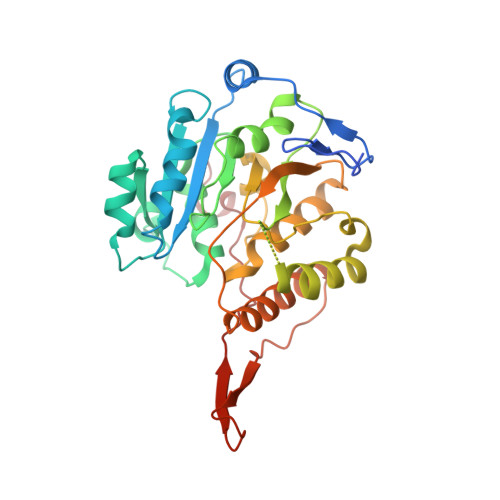Crystal structure of a UDP-glucose-specific glycosyltransferase from a Mycobacterium species.
Fulton, Z., McAlister, A., Wilce, M.C., Brammananth, R., Zaker-Tabrizi, L., Perugini, M.A., Bottomley, S.P., Coppel, R.L., Crellin, P.K., Rossjohn, J., Beddoe, T.(2008) J Biol Chem 283: 27881-27890
- PubMed: 18667419
- DOI: https://doi.org/10.1074/jbc.M801853200
- Primary Citation of Related Structures:
3CKJ, 3CKN, 3CKO, 3CKQ, 3CKV - PubMed Abstract:
Glycosyltransferases (GTs) are a large and ubiquitous family of enzymes that specifically transfer sugar moieties to a range of substrates. Mycobacterium tuberculosis contains a large number of GTs, many of which are implicated in cell wall synthesis, yet the majority of these GTs remain poorly characterized. Here, we report the high resolution crystal structures of an essential GT (MAP2569c) from Mycobacterium avium subsp. paratuberculosis (a close homologue of Rv1208 from M. tuberculosis) in its apo- and ligand-bound forms. The structure adopted the GT-A fold and possessed the characteristic DXD motif that coordinated an Mn(2+) ion. Atypical of most GTs characterized to date, MAP2569c exhibited specificity toward the donor substrate, UDP-glucose. The structure of this ligated complex revealed an induced fit binding mechanism and provided a basis for this unique specificity. Collectively, the structural features suggested that MAP2569c may adopt a "retaining" enzymatic mechanism, which has implications for the classification of other GTs in this large superfamily.
Organizational Affiliation:
Protein Crystallography Unit, Department of Biochemistry and Molecular Biology, School of Biomedical Sciences, Monash University, Clayton, Victoria 3800; Australian Research Council Centre of Excellence in Structural and Functional Microbial Genomics, Monash University, Clayton, Victoria 3800.

















